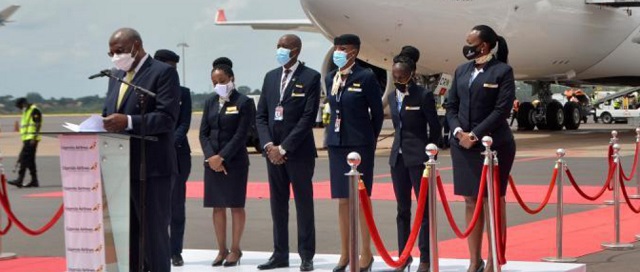
UCAA’s delay in concluding aircraft certification process cited
Kampala, Uganda | ISAAC KHISA | State owned Uganda Airlines has secured landing slots at London Heathrow International Airport in the United Kingdom and Dubai International Airport in the United Arab Emirates but it is not ready to start servicing the routes, The Independent has learnt.
Responding to a number of media reports about the launch of long haul flights that also include Guangzhou in China and Mumbai in India, the airline said the industry regulator, the Uganda Civil Aviation Authority (UCAA), is yet to complete clearing the two new Airbus A330-800Neo aircraft to fly.
Uganda Airlines got two Airbus A330-800Neo aircraft in the past two and half months to service long haul flights but the planes remain grounded at Entebbe International Airport, keeping national assets worth billions of shillings on the ground instead of flying and earning revenue.
“This is a five-phase programme which once complete will result in addition of the aircraft to the Uganda Airlines Operator Certificate…Dates for the start of operations to each of the destinations will be announced soon,” Uganda Airlines said in a statement published on March.03.
However, UCAA has remained silent on the matter and the entity’s spokesperson, Vianney Luggya, could not respond to our calls by press time. Currently, Uganda Airlines flies to nine destinations mainly in eastern and central Africa using the CRJ-900saircraft.
Uganda Airlines hopes to cash-in on tourism and trade opportunities in Europe, Asia and the Middle East as well as retain part of the US$400 million that the local population spends on foreign airlines to travel abroad per annum.
Data from the tourism ministry shows that outside Africa, Europe is the region that sent the second largest number of visitors (7.4%), followed by the Americas (5.5%) and Asia (5.1%) in 2017 for tourism in the country. Tourist arrivals from India stood at 35,676, the UK (33,564) and China (16,842).
However, in relation to trade, Uganda’s trade with the United Kingdom dropped over the past five years. Last data from Bank of Uganda shows that the country’s export earnings from the United Kingdom dropped from US $26.8million in 2015 to US$10.3million in 2020 and so is the import bill that dropped from US$71.9mllion to US$ 60million during the same period under review.
Nevertheless, Uganda’s export earnings to China increased from US$57.6million in 2015 to US$40.02million in 2020. However, China’s exports to Uganda grew much faster from US$736million toUS$1.1bn during the same period.
Similarly, Uganda’s exports to India surged from US$22.5million in 2015 to US$64.5million. However, imports dropped drastically from US$994.9million to US$742million.
Surprisingly, earnings from exports to the United Arab Emirates increased more than nine-fold from US$ 205.8million in 2015 to US$1.8billion in 2020. However, imports which had increased from US$338million before peaking at US$644million in 2018 dropped to US$380 million in 2020.
Uganda exports mainly gold and agricultural products including flowers, fruits, vegetables and imports machinery and processed products.
Stiff competition
Launching the new route destination means that the Uganda Airlines is ready to tussle it out with the Middle East carriers – Emirates, Flydubai and Qatar airlines on the Entebbe – Dubai route, Kenya Airways, Air Tanzania, Ethiopian Airlines and RwandAir through their hubs on Entebbe – Mumbai and Entebbe –Guangzhou routes.
However, Uganda Airlines will enjoy a monopoly on the Entebbe – London Heathrow route following British Airways decision to suspend flights on the route in 2014 saying that it had become ‘commercially unviable.’
This comes as data from the International Air Transport Association (IATA) shows that passenger traffic fell in January 2021, both compared to pre-COVID levels (January 2019) and compared to the immediate month prior (December 2020).
The total air traffic demand in January 2021 (measured in revenue passenger kilometers or RPKs) was down 72.0% compared to January 2019. That was worse than the 69.7% year-over-year decline recorded in December 2020.
The total domestic demand was down 47.4% versus pre-crisis (January 2019) levels. In December it was down 42.9% on the previous year. This weakening is largely driven by stricter domestic travel controls in China over the Lunar New Year holiday period.
The International passenger demand in January was 85.6% below January 2019, a further drop compared to the 85.3% year-to-year decline recorded in December.
African airlines’ traffic dropped 66.1% in January, which was a modest improvement compared to a 68.8% decline recorded in December versus a year ago. January capacity contracted 54.2% versus January 2019, and load factor fell 18.4 percentage points to 52.3%.
“2021 is starting off worse than 2020 ended and that is saying a lot. Even as vaccination programmes gather pace, new COVID variants are leading governments to increase travel restrictions. The uncertainty around how long these restrictions will last also has an impact on future travel,” said Alexandre de Juniac, IATA’s Director General and CEO.
“Forward bookings in February this year for the northern hemisphere summer travel season were 78% below levels in February 2019.”
Freight picks up
However, global air cargo demand returned to pre-COVID levels (January 2019) for the first time since the onset of the crisis, with the African airlines’ cargo demand soaring 22.4% compared to the same month in 2019, eclipsing the 6.3% year-over-year increase for December 2020. The robust expansion on the Asia-Africa trade lanes contributed to the strong growth.
****
 The Independent Uganda: You get the Truth we Pay the Price
The Independent Uganda: You get the Truth we Pay the Price



“Tourist arrivals from India stood at 35,676.”
Tourists or prospective immigrants?!